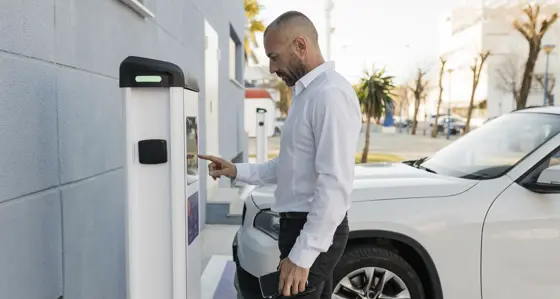
Beyond early adopters: how to scale home decarbonisation
23 October 2023
We hosted our third Green Buildings and Transport Forum on 10 October 2023, bringing together 40 attendees from a range of organisations – from energy suppliers and green financers to installers and innovative solutions providers.
The discussion was rich and centred around a key question of how to move beyond the early adoption stage of home decarbonisation and into the mass market.
Catching early adopters is relatively straightforward. They’re excited by the possibilities and keen to test new technology. However, we need to go further, pushing through to the mass market.
Whilst EVs adoption is further along this journey than low carbon heating solutions, the ecosystem is struggling to progress into mass market provision.
During the roundtable there was much debate and challenge on the blockers to adoption, and how we can overcome these challenges.
How do we shift the dial on domestic building decarbonisation?
Our roundtable agreed that there are three overarching reasons why scaling is so difficult:
-
Consumers lack trust – in technologies, incentives, and providers, and they don’t see enough social proof points to reassure themselves.
-
Messaging is simultaneously too generic and too complex – people must easily understand what solutions they need, how to use them, and how they’re tailored to their lifestyle – not just their house type or postcode, but to their own personal journey through the transition.
-
Costs are (often prohibitively) high – and there’s not enough understanding of the value.
How can we overcome these barriers?
Four themes appeared from the discussion:
-
focusing on the big picture instead of the individual puzzle pieces.
-
enabling open data – creating the ability to generate personalised insights.
-
concentrating on the early part of the customer journey.
-
reframing the business case to improve financing models.
Let us look at each of these themes in more detail.
Focus on the big picture, not the individual puzzle pieces
To build trust and go beyond generic messaging, the ecosystem must take an integrated approach to the end-to-end customer experience.
George Batts, head of strategy at MyEnergi, gave us a great analogy: “Many efforts to drive adoption have focused on individual puzzle pieces – the EV charging, solar, residential storage, heat pumps, home energy management systems and financing. But consumers need to understand and buy into the picture on the front of the puzzle box. We as an industry need to define what that picture looks like across hardware and software and from financing, design, and installation through to service and optimisation. And that picture needs to be comprehensive and compelling for customers”.
Enable open data – and the ability to generate personalised insights
Real-time data must be shared across the ecosystem
That holistic and customer-centric approach requires access to the right data.
Casey Cole, CEO of Guru Systems, discussed the importance of data sharing: “We need data transparency across system design, financing, commissioning, and optimisation. There needs to be a tight data feedback loop to deliver results for consumers – and scale the transition.”
Will Ephraim, head of business development at Eliq, made an interesting observation: many solutions are hampered by their reliance on EPC data. “EPC is a static data point, so it doesn’t show progress from a carbon reduction perspective. We need a better springboard for moving beyond a generic approach,” he explained.
“The key is real-time, open energy data from smart meters and equivalent data hubs. We need the ability to break down that data and make it easy for people to understand. For instance, how much is going on heating versus hot water? What will next month’s bill be?” Will added. “But the major value comes from tailored recommendations, where we analyse a customer’s data against aggregated datasets and provide next best actions for saving money (and carbon). When you get customer consent and can coordinate between providers, utilities, and banks, you can start driving meaningful savings”.
Data also plays a key role in boosting affordability
Data transparency is also critical to addressing the affordability barrier, according to Casey: “We need data transparency across system design, financing, commissioning - and then when the building is in operation. There needs to be a tight data feedback loop to continually optimise systems and deliver results for consumers”.
Participants from financial institutions also stressed how data sharing can help increase homeowners’ borrowing capacity. If lenders have reliable, personalised data on running costs, they can make more accurate affordability calculations – increasing the amount people can borrow (and opening up more money for installations).
Concentrate on the early part of the customer journey
Low carbon heating solutions are at a disadvantage compared with EVs because they’re often caught up in a distress purchase situation. To address that challenge, we need greater investment early in the customer journey. This means we must educate people (in a personalised way) before their boilers break, providing a holistic view of the right options for their property. There’s a big knowledge gap when it comes to technologies such as heat pumps, heat networks, ground source loop arrays, and heat batteries, so the earlier that education process begins, the better.
Every interaction is an opportunity. And there should be proactive outreach from energy suppliers and those involved with asset management. Again, data is critical.
For instance, smart meter data can help flag if an asset is nearing end of life, like if it’s taking a boiler longer to hit target temperatures. You can then approach customers proactively and have time to go through the system design and funding process.
Another example involves integrating with debt book data. With more open and available data, suppliers can reach out to struggling customers and support them to access funding for upgrades that will reduce bills. This has the added benefit of giving suppliers an opportunity to discharge their obligations more cost-efficiently, reducing the commercial impact of ECO4 while improving outcomes for customers.
Reframe the business case to improve financing models
Social value should be part of the calculus
To help tackle the cost barrier, we discussed the importance of quantifying and communicating the wider value of energy efficiency. This reframes the business case.
In 2023, Baringa and Citizens Advice researched the benefits of upgrading 13 million homes to EPC C. The figures were staggering – a £40 billion boost to GB PLC by 2030.
Beyond the £23.8 billion of direct consumer bill savings and £4 billion of savings from reduced network pressure, the research found broad health and social benefits:
-
£2 billion in NHS savings – from preventing physical and mental health conditions related to cold homes.
-
Reduced pressure on NHS services – 30% reduction in patient numbers for cold-related conditions during the winter peak season.
-
£9.3 billion of societal savings – by avoiding excess winter deaths, gas emissions, and electricity emissions.
At the roundtable, Naomi Schraer, senior policy researcher at Citizens Advice, highlighted that it’s not just about the consumers’ financial savings (although that is clearly significant). “It is also about how upgrading inefficient homes trickles down through other areas – improving quality of life, enhancing energy security, and helping people participate in society more fully because they are healthier”.
Naomi explained that another outcome from the research was that “areas with higher deprivation are more likely to have energy inefficient homes, so the benefits of upgrading are localised. The research calculated £5 billion of benefits to the North West by 2030. There’s a strong fairness element – we see major impacts in areas that would otherwise have been at risk of being left behind.”
Steph Budenberg from Baringa also emphasised the importance of this research for financial policy planning: “The social value has an economic benefit, which enhances the business case. When you quantify the medium and long-term savings like this, industry and government can more easily collaborate to develop funding models supporting the transition.”
We need more clarity and accountability
Reframing the business case is important, but to boost affordability at scale, we also need more accountability for elements affecting the accessibility of funding.
We discussed three elements to this:
-
Central government – we need clear, consistent, long-term policies that incentivise mass adoption and help the UK ecosystem benefit from global best practices and experiences. For example, other countries have piloted schemes like salary sacrifice for low carbon heating solutions, deferring payments until a property is sold, and linking financing to properties rather than people.
-
Supply chain – on the one hand, the supply chain needs to mature because costs will naturally fall when competition increases. On the other hand, it is hard to get a busy sector to focus on retrofits that involve certifications and complex funding schemes. The trust issue comes into play, too, in terms of willingness to invest. Who is accountable for their system? Who do they call if there is an issue?
-
Local government and social housing – looking at ways they can get the societal benefits on their books and into their budgets, so they can more easily fund schemes across their stock.
These aren’t just energy industry challenges – the ecosystem must come together to tackle this problem
Amid a backdrop of policy uncertainty, scaling beyond early adopters is an ecosystem-wide challenge. Low consumer trust, generic messaging, and high costs must be tackled if we’re going to excite that early majority (and mass market) about decarbonisation.
Our next Green Buildings and Transport Network roundtable will be in February 2024. If you’d like to join the discussion, get in touch. To hear about future Baringa events, look out for updates in our Energy and Natural Resources newsletter.
Is digital and AI delivering what your business needs?
Digital and AI can solve your toughest challenges and elevate your business performance. But success isn’t always straightforward. Where can you unlock opportunity? And what does it take to set the foundation for lasting success?

